Speech The Economic Outlook in 2002

Glenn Stevens
Deputy Governor
Address to CEDA Economic and Political Outlook Conference
Adelaide –
It is a pleasure to be invited to speak to CEDA's Economic and Political Outlook in Adelaide. I have taken part in CEDA functions at this time of the year in other cities, but it is particularly nice to come to Adelaide.
I would like to note at the outset, for the benefit of the local audience, that the Bank has undertaken a considerable increase in the resources put into "on the ground" economic intelligence around the country. During 2001, we established Regional Offices in Victoria, Western Australia and Queensland. In those States, the Bank's branches had earlier been closed because their original functions – banking and registry operations, currency distribution – were either no longer demanded by customers or had been overtaken by improved technology. The purpose of the Offices is to retain some RBA presence and, more fundamentally, to gather information about local economic conditions. In South Australia, of course, the Bank still has a presence in the form of a Branch operation which conducts banking business for the South Australian Government. So as part of the process of strengthening our liaison effort, during last year we re-positioned one of our economists from Head Office to the Adelaide Branch.
The local staff are in continual contact with the Economic Group in Head Office and they take an active part in the assessment of the economy in the preparation for the monthly Board meetings. We have found the information gathered at the local level to be extremely helpful and are very grateful for the way businesses, government departments and agencies and other groups have responded to our questions.
The South Australian economy has turned in a reasonably strong performance over the past year, with growth in household demand running above the national average. In common with some of the other States, South Australia's export exposure no doubt means that businesses here will be keeping a watchful eye on events abroad. Equally, the apparent intention of the mining sector to begin raising its capital spending, according to the available surveys, will probably be good for South Australia.
I do not intend to attempt a detailed analysis of local economic conditions. Instead, most of my remarks will be about the global and national scenes. The world economy presents no fewer sources of uncertainty, and hence no less potential for surprises, than it has for a number of years now, though from the perspective of the international business cycle, there are some quite encouraging signs at present of a turning point. In Australia, the economy has clearly coped with the international downturn pretty well so far, and there are good reasons for confidence about its performance over the coming year.
As it happens, the Bank has just published a Statement on Monetary Policy, containing our comprehensive analysis of the international and Australian economies. My task today is to elaborate some of the themes in that document, rather than to bring any new messages.
The US business cycle
On 26 November 2001, the US National Bureau of Economic Research announced that, according to the methodology they use for dating business cycles, the US economy had reached the end of a decade-long expansion in March 2001, after which it had been in a period of contraction.
That pronouncement effectively ended the debate about whether there would or would not be a recession – defined by the NBER as “a significant decline in activity spread across the economy, lasting more than a few months, visible in industrial production, employment, real income, and wholesale-retail trade”. One had apparently been under way for eight months.
It is not that unusual, by the way, for such classifications of recession and expansion to lag the actual event by a good few months. In fact, it is not unknown for a recession to be actually finished by the time the data make it clear that one had begun (though the fact that it had finished was itself, of course, not known until later). This was the case in the early-1990s recession in the United States. Note also that there have not, as yet anyway, been two consecutive quarters of declining GDP in the United States – the definition of "technical" recession so beloved of the headline writers.
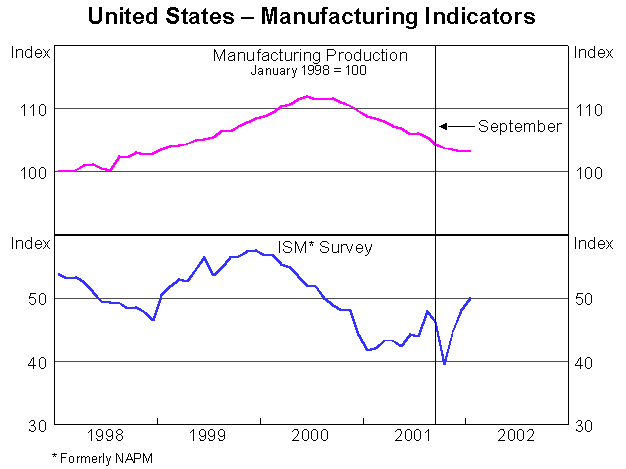
Debate quickly moved on, focusing briefly on the role of the September 11 events affecting the economy. Clearly, those events did not cause the recession. All the dynamics typically associated with a contraction in output were in train prior to mid September – otherwise the NBER would not have been able to decide by November that there was a recession under way. Moreover, the direct impact of the attacks themselves was, despite the horrifying images, not all that large on the US economy. Arguably, though, they came at a time when the US economy was already contracting and accelerated the adjustments by businesses to the underlying reality which was emerging. Certainly, the event was a watershed for commentators. Those voices saying there would not be a recession went quiet immediately, some weeks before the NBER's pronouncement. But a business cycle contraction was definitely under way prior to September 11.
The NBER's statement was only 12 weeks ago. Between late November and today, many observers have begun talking about a US recovery. Financial market prices reflected this change relatively early on, as they tend to do. Share markets rallied strongly through the last weeks of 2001 and into the early part of this year, though the shine has come off a little since then. Bond markets pushed up long-term interest rates somewhat, and credit spreads for corporate bonds have tended to decline. Forecasts of economic growth in the United States appear to have stopped falling, and the latest actual figure for GDP, while weak in an absolute sense, was stronger than most had expected, and much stronger than many feared in the early days after September 11.
To no small extent, this reflects the fact that the underlying US economy weathered the impact of the terrorist attacks themselves very well. Post-attack, the financial system was up and running again very quickly, especially given the destruction of physical infrastructure at the heart of the system. And while American corporations have cut their investment spending very sharply indeed, households have continued to increase their spending on consumer goods and services. Macroeconomic policy has been supportive, with a tax cut affecting household incomes during the second half of 2001 – right when it was most needed – and a very rapid easing of monetary policy beginning in early January 2001, and continuing with force right through the year.
In fact, if one were to adopt the view that a recession began last March and, noting that recessions typically (if there is a typical recession) last about a year, to set about looking for signs that an upturn might be near, one would find some evidence in the real economy to support that view. Inventory adjustment, part of the classical business cycle story – and very much a part of this recession in the "new economy", especially in the production of IT goods themselves – began quite early, and is by now well advanced. The adjustment to investment spending has been quick. Signs of a bottoming in parts of the tech sector have begun to emerge. The adjustment to business payrolls may also have gone a long way towards completion, judging by recent labour market data.
So an analysis of the normal business-cycle dynamics does increasingly suggest that the US economy could well begin a new expansion soon. If it does, the US recession would have been no deeper, and probably shallower, than the one in 1990–91, which was the mildest recession in the past three decades.
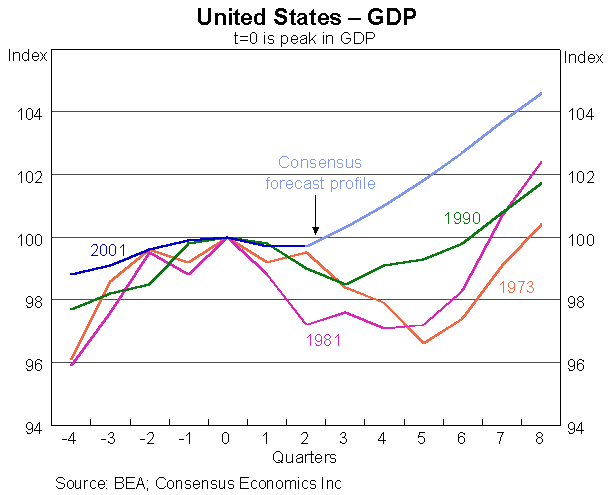
Such an outcome is by no means yet assured, and it is entirely possible that there will be setbacks, and associated fluctuations in sentiment. Those inclined to a pessimistic view would, of course, point to some other features of the US economy which I have not, as yet, mentioned. It seems likely, for example, that there was excessive investment in certain areas during the height of the euphoria over returns to information technology. Even though new investment has been slashed, an overhang of past investment might remain – and hence scope for an early return to rising business investment spending may be limited, though this depends on the speed with which equipment becomes obsolete, which is much higher for ITC-type investment than for, say, buildings. To the extent that a good deal of the investment was simply "wasted", there is presumably not much overhang – but in that case the question is whether the full extent of the lost wealth entailed is yet apparent. We could also add that the true state of corporate balance sheets is more uncertain in general, as highlighted by the recent revelations of accounting irregularities in some high-profile US firms, and that American share valuations still seem high by historical standards, supported by exceptionally strong forecasts of earnings growth.
Households have expanded spending beyond the rise in their income over the past year – indeed they have done so over a number of years. That can be sustained only for so long, especially given more subdued gains in wealth. Can the household sector keep the US economy ticking over while the business sector sorts itself out? Or will the loss of wage income resulting from the higher unemployment dampen consumers' enthusiasm?
Opinions on these and other uncertainties differ. The weight of opinion has, I think rightly, become more optimistic lately, but the pessimists who doubt that a recession can be over so quickly are not without their reasons. Even some of those who are relatively optimistic might concede that factors such as these may well mean that the rate of expansion is initially relatively modest, and certainly slower than the growth seen in the late 1990s.
Other areas of the world economy
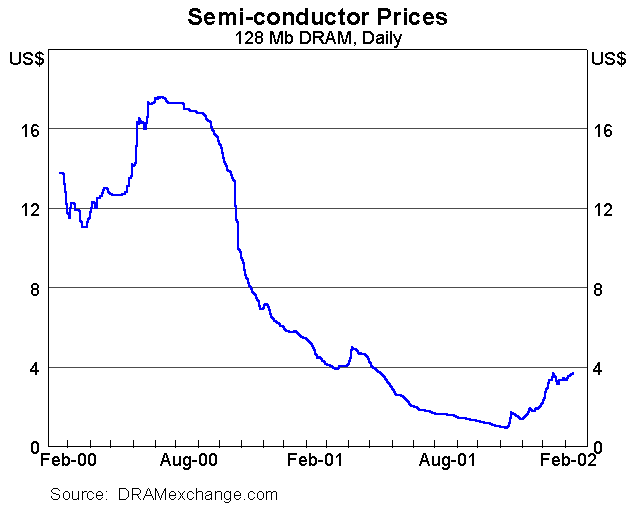
What of other regions?
I think we can see evidence in a number of countries in east Asia that the contraction in industrial production came to an end during the closing months of 2001. These countries were hit very hard by the global tech sector slump during 2000 and 2001, which affected their exports. Some countries which were not badly affected by the Asian crisis in 1997 and 1998, but which have very extensive exposure to technology production, such as Singapore and Taiwan, have suffered much more on this occasion than they did three or four years ago. But for east Asia as a whole, the impact has not been as serious. In contrast to events during the Asian crisis, macroeconomic policies on this occasion have acted in a way which has cushioned, rather than reinforced, the impact of global events. Exchange rates have been allowed to decline, and monetary and fiscal policies have generally been eased.
Activity seems to have stabilised recently. Semi-conductor prices have firmed appreciably, having collapsed over the first nine months or so of 2001. As an example of the roller-coaster ride producers in this area have experienced, consider the price of memory modules published by a web-site called DRAMexchange.com. In October 2000, the price quoted for a 128mb SDRAM module was about US$10. By October 2001, it had fallen to US$1. Some of the fall was, no doubt, the decline over the (very short) life span of high-technology components with which we are familiar – driven by productivity improvement and competition. However, much of the fall presumably reflects the cyclical dynamics. Over the past few months, prices have risen to around US$3.50. It is encouraging for the small east Asian countries to see this, and to see hopeful signs of expansion in the United States, which remains such a powerful force driving the business cycle for externally oriented economies.
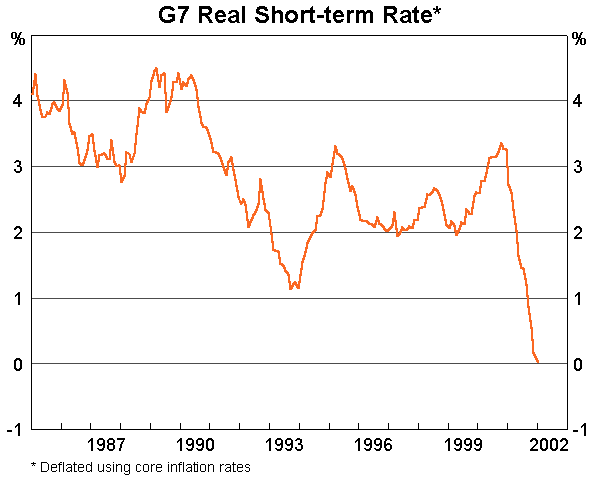
In Europe, growth slowed noticeably in 2001. However, in some surveys one can see very early signs of what should turn out to be an improvement in economic conditions over the year ahead.
Japan, unfortunately, is in quite a different position. Japan was affected by the tech sector slump, but it is also afflicted with very powerful forces at work in its domestic economy. Deflating asset prices, associated pressure on corporations and banking sector asset quality, and generalised price deflation in producer prices and even consumer prices, make for a very difficult situation. These dynamics have been in operation for some years, but appear to have intensified over the past year or so. Conventional macroeconomic policies have been pushed to their limits. Structural reform is necessary but will be painful in the short term. While attention has been (understandably) fixed on developments in the United States, the biggest threat to the world economy in terms of the drag on aggregate economic activity may well be Japan. How things will play out there remains extremely uncertain.
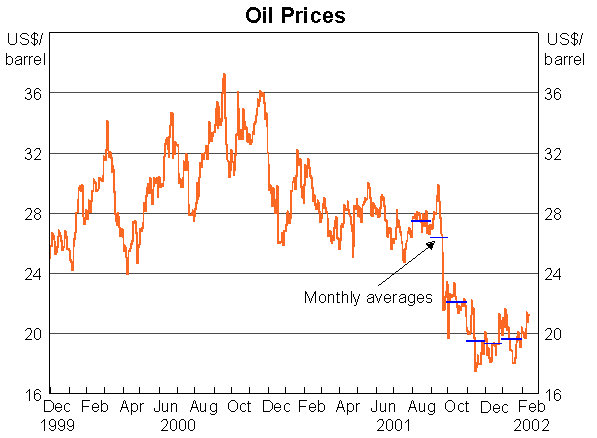
But overall, barring a sudden and major further intensification of contractionary forces in Japan, there are reasons to think that global economic activity will begin to improve this year. A pretty strong policy stimulus has been applied, led by the United States, in a timely fashion. Global short-term interest rates are unusually low. In addition, the price of oil, which played an important role in producing the slowdown, has fallen substantially over the past year. These two factors, plus the outworking of inventory overhangs, would usually be enough to produce a cyclical upturn. As I have sketched above, we can see evidence beginning to appear which is consistent with that view. For these reasons, as our recent Statement on Monetary Policy made clear, some of the pessimism about the United States, and hence the world economy, that existed a few months ago has waned.
The question may soon be, not whether there is an upturn, but how strong and durable it will prove to be. At this stage, that is unclear, and it probably will remain so for a while.
Implications for Australia
It is well recognised that the Australian economy has been quite resilient in the face of the global recession. Growth through the first three quarters of 2001 ran at an annualised rate of 4 per cent. Even a moderate increase in GDP in the December quarter, which is what most observers expect, would mean that growth through the full year would be of the order of 3½ per cent. That compares well with the growth for the United States of about zero for the same period, and with the outcome for the major countries as a group, which was also about zero.
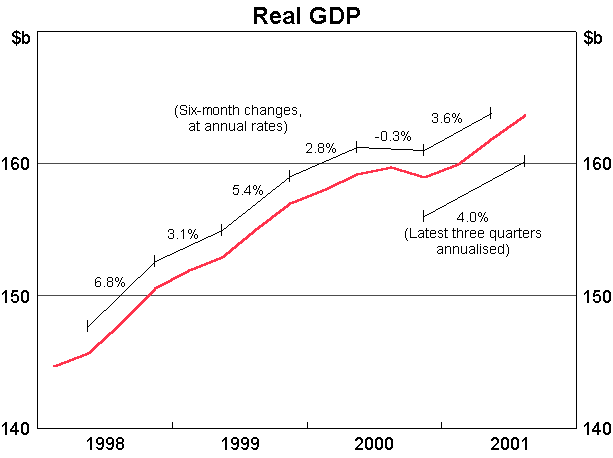
In past periods of global downturn, Australia has rarely outperformed the major countries; historically, our tendency was to have a period of weakness that was, if anything, more pronounced than those of the G7 group. This time it has been different, though not because the global recession has not affected Australia: the impact on exports has become increasingly clear over the past six months or so. The value of exports, which was growing at 25–30 per cent per annum at one point, is little changed now compared with a year ago. The contribution to growth in GDP from net export volumes ran to about 2 percentage points in the year to June 2001, but was negative during the second half of 2001.
So two questions can be posed. First, why is it that on this occasion, so far at least, we have done better than on others? And second, will it continue?
A lot has been made of the housing upswing which is currently increasing activity and employment in the construction sector and associated parts of manufacturing. It is true that this is helping growth at present, and that it will most likely fade from the middle of the year. But of course it is equally true that we "paid for" this boost with a large contraction – of unprecedented size, in fact – during the second half of 2000. We took a brief but very large housing downturn at a time when the world economy was still doing acceptably well, and then got the benefit of an upswing in housing as the world slowed. The timing of this was not, of course, something over which we had any control.
Looking through the ups and downs of the housing sector, it is still the case that the Australian economy has performed better than in other episodes of global recession. This is not to deny that growth has declined – in some underlying sense, stripping out the housing fluctuations, growth might have run at something like 2½ per cent over each of 2000 and 2001. That is noticeably slower than the outcomes for 1998 and 1999 (which were exceptional). But it is still a better performance than those in the US and most other major countries, and better than an extrapolation of historical experience in previous global downturns might have suggested.
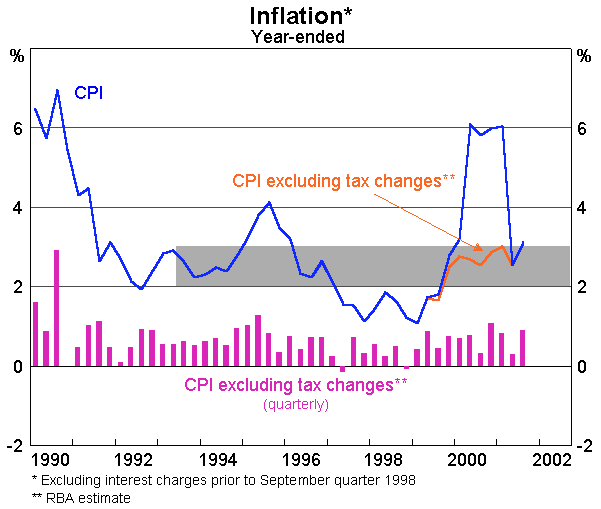
We should also, of course, keep in mind that the full effects of the global downturn on Australia are probably not yet apparent. Even so, as we begin to get the very early pieces of economic information for 2002, it seems that business and consumer confidence has held up quite well, and there are some signs of improvement in demand for labour. All this is consistent with growth continuing thus far. So the question remains as to why that has occurred.
One major factor which has helped has been that few of the problems which have dogged us in past episodes, and hence exacerbated business cycle downturns, have been present on this occasion.
The obvious one which a central banker would nominate is inflation, which has increased, but not beyond manageable levels. Core inflation picked up from about 1½ per cent in 1998 and 1999, to about 3¼ per cent, on our reading, in 2001. As I am sure you know, the centre-piece of Australia's monetary policy regime is an inflation target of 2–3 per cent, on average. This system has been in place since 1993, and has worked well for Australia over that period. It requires the Bank to move our policy instrument so as to keep medium-term inflation outcomes consistent with the target.
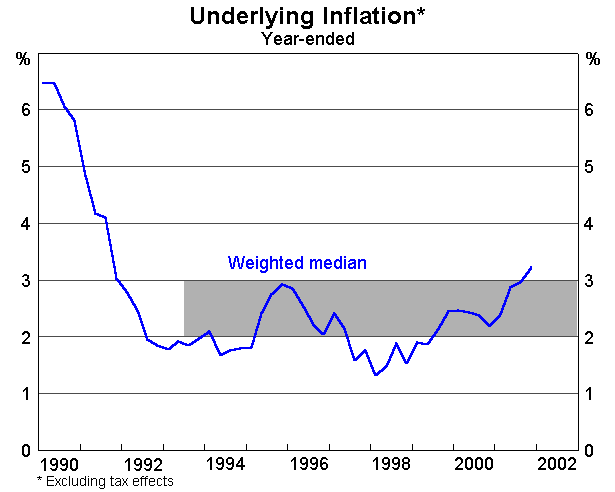
During 1997 and 1998, inflation was below target. Monetary policy's response was to ease, seeking interest rates low enough to engender a stronger expansion of aggregate demand in the economy. The intention of this was to allow inflation to increase a little, back up to the target. By the second half of 1999, it was apparent that the period of below-target inflation was drawing to a close. In anticipation of higher inflation, policy began to move interest rates up from unusually low levels to more "normal" levels, a process which continued through to August 2000.
During 2001, even as inflation was still increasing, ultimately moving above our target, monetary policy was eased substantially. We felt that the previous tightening phase had done enough to ensure that this rising trend would not persist, and therefore that we had some latitude to offer support to growth in the face of the contractionary shock heading our way from abroad. Even though the recent CPI figure was interpreted by many as a bit on the high side, we still think that the outlook is for inflation to return to target over the next four to six quarters. The reasoning behind that is set out in the Statement. For our purposes here today, the point is that the flexibility to put interest rates down pre-emptively is earned by being prepared to put them up when a rise in inflation is on the cards. Policy has operated in such a fashion.
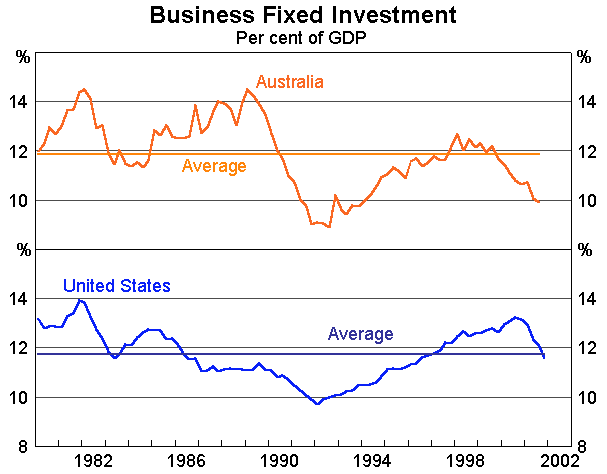
Another imbalance we have managed to avoid on this occasion is excessive investment. Here there is a distinct contrast with the United States, where business investment spending was exceptionally high by historical standards until 2000, and then slumped sharply. It is that item of spending which, more than any other component of aggregate demand, pushed the United States into recession. In Australia, business investment as a share of GDP peaked as far back as 1998, and has gradually declined for three years. While some people might look at this and say that that is a terrible outcome, I tend to look at it and say that it won't fall further. Indeed, with investment at historically low levels, a rise is more likely than a fall in the next couple of years. The forward-looking data provided by the ABS survey say the same thing.
To the above we could add that the Australian share market was never characterised by the extent of excesses seen elsewhere, and that household and corporate balance sheets are, by and large, in pretty good shape – though households are now carrying a good deal more debt than they did in the past. Prior financial excesses would be highly likely to play a part in worsening any downturn if and when it occurred; having avoided the worst of such excesses is a big help. We can further add that fiscal policy expansion during 2000 was remarkably well-timed from the perspective of stabilising the business cycle. Yet another factor is that Australia's terms of trade have not slumped in the way they have so often done in the past; indeed, until quite recently the terms of trade had been rising. This is of some importance in that it supports domestic incomes, at a point in the cycle when, historically, those incomes have been reduced by global price developments.
Then there is the exchange rate. The decline in the currency in the first half of 2000 was not well explained at the time, but there is no doubt it has conferred an advantage on Australian producers of tradeable goods and services. There is, however, more to the exchange rate story than that. A floating exchange rate system means that an adverse change in capital markets' sentiment towards the country is not automatically reflected in tighter domestic financial conditions: the exchange rate can take at least some of the adjustment. That means that domestic demand is not crunched because of pressure on the currency. This particular piece of our economic structure helps the economy adapt to shocks in international capital markets more effectively than the alternative, of a fixed exchange rate, would allow. That flexibility is not without limit, of course, and needs to be complemented by an effective monetary policy strategy to provide an anchor for the system – which is where inflation targeting comes in.
So a number of factors have assisted the economy in coping with the external shock. Can this good performance continue?
To state the obvious, it depends how long the international economy remains weak. No economy can remain insulated from global problems indefinitely. But if the consensus view of global growth – that things will begin to improve as 2002 progresses – is correct, then Australia's prospects are pretty good. The general effects of low interest rates will still be filtering through the economy for some time yet. Prospects for an upswing in business investment would be good in this scenario, which would help to counteract the impact on domestic demand of a waning in the housing cycle. The good growth seen in 2001 will help to put a floor under the labour market, and in due course, improved conditions abroad would offer better prospects for exporters. This does not rule out a temporary weak period for Australian growth at some point during this year, but if the world economy is improving, macroeconomic policies are supporting growth and investment is beginning an upswing, it would be unlikely that activity would fall away very sharply or for long.
None of this is assured, in large part because the global recovery itself, while apparently more likely than it was, is no sure thing. But then nothing is ever assured. What appears to have changed in recent months is that the balance of risks to global growth and to the Australian economy is no longer "tilted to the downside", in the way it was. It is still possible to conceive of a weaker outcome than the consensus expects – but for the first time in over a year, it is also just possible to conceive of the possibility that things could be stronger than generally expected.
Conclusion
The year 2001 saw a major change in perceptions about the health of the world economy, with recessions or near-recessions in several major countries. As of early 2002, it appears that the point of deepest gloom is behind us, and that people are starting to think about the shape of a renewed period of expansion which will probably get under way this year. This improvement is not assured and there could be setbacks. But the position we are in now is, in most respects, decidedly preferable to that of a year ago.
For Australia, this is good news, even though the benefits of it will show up with a lag. The economy has held up quite well in the face of international weakness, and it should continue to do so, for some time at least. If the recent hopeful signs of a global pick-up do turn into a sustained period of expansion, even if only at a moderate pace, Australia will be well placed to continue turning in good macroeconomic outcomes over the slightly longer term.